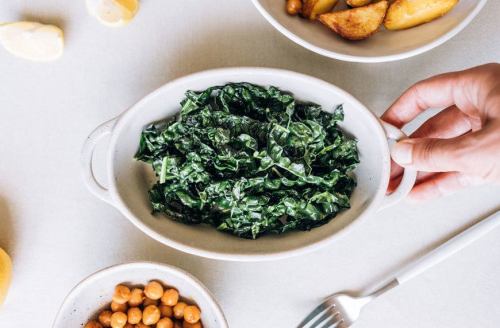Once and for all: WTF does it actually mean to massage your kale?
To get the most out of these superfood greens in terms of taste and nutrition, chef Bruce Kalman explains exactly how to massage kale.

Ever since kale became the trendiest superfood on the planet, I’ve heard one technique and over again: massage it. It’s supposed to break down the toughness of the leaves to make them softer and less bitter, giving you a bowl of greens that not only tastes better but is easier to digest. But what does it mean to massage your kale, exactly?
To me, massaging kale sounds like it should be a totally Zen spa experience. Like, if kale had eyes, cucumber slices would most definitely be placed on them. And instead of olive oil, it’d be getting slathered in relaxing essential oils. Unfortunately, there’s no R&R for these greens. But, good news: Working out kale’s kinks doesn’t require nearly as much effort as your own.
“When making a kale salad, people always talk about ‘massaging’ the kale to tenderize it, but it’s not like giving someone a massage,” says chef Bruce Kalman, owner of BK Hospitality Group. “The method I use basically requires you to gently rub the kale leaves through both of your hands until you notice it beginning to soften up. It should take less than a minute. If you overwork it, it won’t have any sort of texture, and you really want your salad to be crisp, but not tough.”
While massaging kale is undoubtedly the most common and quickest method of breaking down those chewy fibers—especially when you’re doing so around the same time you want to eat!—Kalman has a different technique that you can use for big meal prep-worthy batches, which requires no massaging whatsoever. “Another method I really like is brining the kale leaves in cold, salted water,” he says. “You just need 1 1/2 gallons of cold, filtered water, 1/4 cup of kosher salt, and three bunches of Tuscan kale with the bottom two inches of the stems removed.”
Kalman says to start by grabbing a large plastic container that holds at least three gallons of volume and combine the water and salt using a wire whisk until the salt is completely dissolved. Then, submerge the kale in the water and cover with a towel to keep it submerged, allowing it to soak for 12 to 24 hours.
“After the time is up—24 hours is ideal—remove the kale from the water and gently shake the leaves to remove excess water, then place leaves on pans with cooling rack to allow the leaves to drain and dry, one to two hours,” he explains. “When the leaves are dry, chiffonade (finely shred) with a very sharp knife, or ceramic knife, so as not to bruise it.”
Whether you decide to give your kale a massage or simply soak it in salty water, you’ll be left with a restaurant-worthy salad with leaves so perfectly tender that you might even convince yourself to bring it to work to eat every day.
Here’s more need-to-know info on kale: how it compares to spinach health-wise and the common kitchen tool that helps you chop a salad super fast. (Hint: it’s not a knife.)
Sign Up for Our Daily Newsletter
Get all the latest in wellness, trends, food, fitness, beauty, and more delivered right to your inbox.
Got it, you've been added to our email list.










